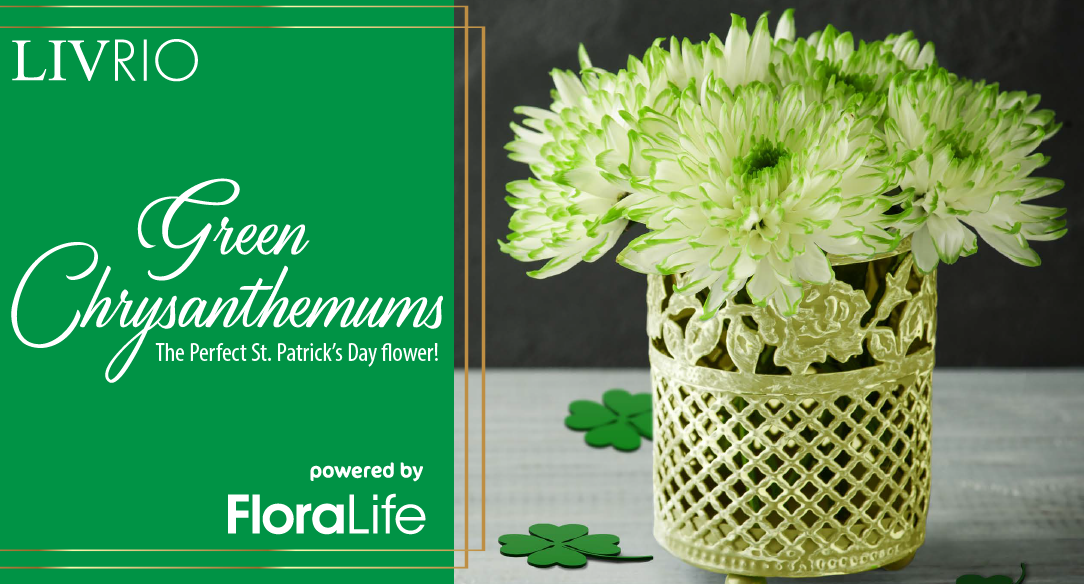Green Chrysanthemums: The Perfect St. Patrick’s Day flower!
LivRio Magazine February 2022, powered by FloraLife

Celebrating St. Patrick’s Day on March 17th is undoubtedly one of the best ways to chase away the winter blues, and welcome the coming of spring and warmer weather, but why do we do it?
St. Patrick, not his real name, was an Irish priest who lived in the 5th century. He was born Maewyn Succat but adopted the Latin name Patricius after becoming a Christian priest. He was well known for persuading Irish druids to take up the Christian faith, but it wasn’t until several centuries later, in the 1600s, that March 17th became known as St. Patrick’s Day.
Since March 17th falls during Lent, St. Patrick’s Day became a feast day, a much-needed day off from the strict abstinences Christians observe in the lead up to Easter. Shamrocks and the color green became associated with St. Patrick’s Day later still, but all are traditions that continue to be observed to this day.
This year, flowers remain the best way to celebrate St. Patrick’s Day. Whether you want to produce a traditionally all green arrangement, or add small accents of color into the mix, either way Chrysanthemums should be your go to flower of choice.
Whether you opt for naturally green varieties such as ‘Green Anastasia’, ‘Bombellini’, or even ‘Lime Green Zembla’, or you’re looking to add a spritz of color to customize a white variety, the options are vast.
But it’s not just in the choice of color where Chrysanthemums reign supreme, they also rule the flower form department too! Because Chrysanthemums grow in a variety of flowers forms from spikey spiders to compact buttons, their versatility knows no bounds.
So, regardless of how you choose to celebrate St. Patrick’s Day this year, make sure to include some beautiful Chrysanthemums in your floral designs.
Care and Handling Tips
Purchasing
- Choose stems with blooms showing full color, and ¾ to fully open; healthy green foliage, flower buds protected and free of physical damage, and free of diseases (botrytis).
Shipping & Storage
- Shipping and storage temperatures should be 34 – 38° F / 1 – 3° C.
- Dry storage is best, but only if temperatures are maintained between 34 – 38° F / 1 – 3° C.
Re-hydration at Store Level and Storage
- Store flowers dry at 34 – 38° F / 1 – 3° C for as long as possible (until flowers are needed for wet case display at store/wholesale level).
- Start processing with a clean bucket, sanitized with D.C.D.® cleaner.
- If received dry packed, conditioning of stem ends is recommended to prevent blockage and promote uptake. Cut approximately 1” / 3cm or more off stems. Use clean, sanitized clippers or knife, and treat with Floralife® Quick Dip.
- Place flowers in a holding treatment such as Floralife® Express 200. Do not put flowers directly in metal/galvanized buckets. Use clean, high quality water that has not been treated with a water softener as the salt levels can be damaging to flowers.
- Store in a cooler at 34 – 38° F / 1 – 3° C with a relative humidity of 75 – 85%.
- Allow minimum 2 hours to hydrate placing buckets in an area with good airflow.
- Always remember FIFO (first in/first out) when rotating flowers.
Vase Care
- Remove any leaves that might be below the vase solution.
- Cut approximately 1” or more off stems. Use clean, sanitized clippers or knife. If received dry, treat with Floralife® Quick Dip.
- Immediately place flowers in vase solutions containing FloraLife Crystal Clear® (the perfect choice for clear vases) or Floralife® Express 300 (the no cut needed solution).
Common Defects:
- Botrytis can develop on the blooms and stems. Always maintain the correct temperature and humidity levels during storage and transport.
- Flowers shattering due to rough handling.
- Foliage yellowing and browning.
- Dehydration.
To learn about flower care or to inquire about products and availability in your region, visit www.floralife.com or contact your local FloraLife representative.
*Product availability depends upon geographical region. Check here for more information.
